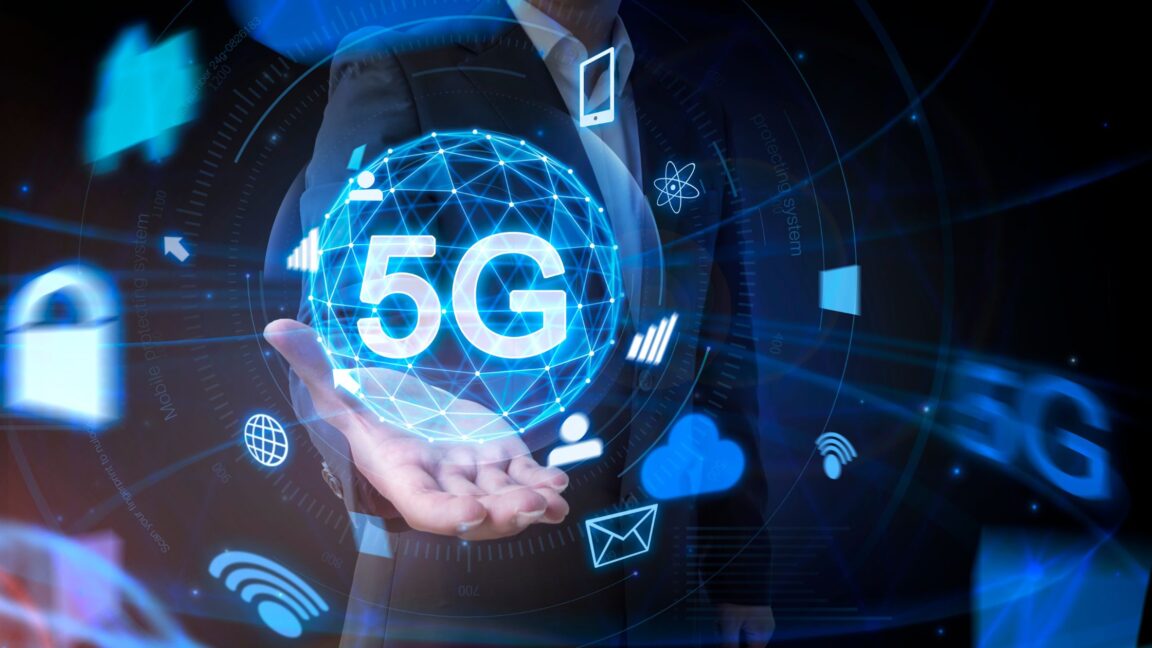The introduction of 5G will transform our technology and provide an entirely new mobile experience for users. This wireless 5G technology was introduced to lower the telecom industry’s maintenance costs and energy consumption. As 5G technologies advance, they will alter how we live and access technology.
Technological advancement is key to overcoming the crisis of pandemics. The appropriate application of technologies will be critical for survival and long-term survival in the post-crisis period. 5G will transform business by providing universal high-speed connectivity and a seamless customer experience from modern mobile networks. It is intended to link everyone and everything, including gadgets, objects, and devices. 5G promises to deliver peak data speeds, reliable communication, and vast network capabilities, resulting in a more consistent user experience.
The Impact Of 5G On The Telecom Industry
Modern communication systems have come a long way since switchboards and long-distance calls, but more than that may be needed: standard, one-size-fits-all network designs have fallen significantly behind in the last decade. In nearly every industry, the telecom industry requires scalable networks that can smoothly adapt to changing demands and must prepare for expanding use cases involving connected devices. While traditional structures still need to meet these demands, 5G systems address many of them. According to one study, 5G technology will deliver speeds up to almost 100 times faster than traditional 4G technology.
However, 5G is much more than an improved replacement for 4G LTE. It’s a new infrastructure approach that brings modularity and flexibility to an industry previously dominated by dogmatic, purpose-built hardware. In many ways, 5G communication technology advances communication technology to meet changing demands, such as:
- Increased data-throughput rates
- Decreased latency
- Energy conservation
- Cost-cutting measures
- System capacity has been increased.
- Massive concurrent device connectivity
- Scale economies
To realize these benefits, these systems must support a broader range of devices, regardless of latency support, coverage area, or other factors. Let’s look at how 5G will affect business, particularly the telecom industry.
5G Will Improve Coverage Everywhere.
Telecommunications providers will make small cell deployments more effective by enabling lightweight, easy-to-install network base stations to increase capacity and coverage in densely populated areas. Lightning-fast speeds will be delivered wirelessly rather than via cable with 5G. As a result, rural and suburban areas will have access to high-speed internet that was previously unavailable via wired connections. High-speed internet access is critical in driving the evolution of rural industries such as farming and agriculture.
Networking-As-A-Service
Network slicing allows various virtual networks to be built on top of a given physical infrastructure. As a result, various applications and services can run on authorized infrastructure. Capacity & coverage can be allocated in logical chunks to meet the specific needs of each user, reducing the need for telecoms to build custom networks for specific tasks or projects and providing connectivity in the most efficient way possible. This enables telcos to provide networking on-demand, resulting in a customer experience similar to that of a physically distributed network.
How Will 5G Affect Your Business?
The fifth-generation technology of public wireless networks is known as 5G. It is more of a leap forward than an evolution from 4G. 4G networks are built with large radio towers that use lower-frequency radio waves to transmit signals over long distances. Many more small-cell antennas will be connected to buildings, streetlights, and other objects in 5G networks. These small cells will transmit massive amounts of data over short distances using an ultra-high-frequency spectrum. The 5G networks of the future will be created by combining various network access points, frequencies, and cloud-based network technologies. 5G network business opportunities have three key characteristics:
- Increased capacity
- Response times that are faster
- Lightning-fast performance
Lower Latency Indicates A Higher Possibility.
Latency is the time it takes for something to be sent and received. 4G latency is currently around 50 milliseconds. 5G latency will reduce this to around one millisecond, faster than the blink of an eye. Low latency is critical for applications that require a true real-time response, such as self-driving cars and remotely controlled robotics. It also means that there will be more opportunities to use augmented reality (AR) and virtual reality (VR).
Innovative businesses that want to use cutting-edge applications like AR, VR, or 3D will be able to do so more effectively with 5G. Lower latency means businesses can stream high-resolution video, audio, and images more quickly and without lag or glitches. This means improved communication with both customers and remote workers. Contractors and interior designers will take clients through virtual rooms before constructing the real thing, allowing for easier decision-making and more accurate results.
The Benefit Of 5G Connectivity
Increasing network capacity increases the number of devices communicating with one another. Although the Internet of Things is becoming more popular, most communication occurs between people using smartphones. With 5G, we’ll see a significant increase in devices and machines talking (communicating) with one another.
Smart cities of the future are expected to have millions of sensors per square kilometer, all connected to the 5G network and capable of supporting IoT devices. This connectivity will aid governments in managing natural disasters to save lives and infrastructure and help emergency responders arrive faster by rerouting traffic.
Companies with machinery will be able to use IoT in conjunction with 5G to maximize equipment efficiency and utilization. A delivery company, for example, can use IoT and 5G to pinpoint a truck’s exact location in real-time to alert the recipient and ensure that the most efficient and effective routes are always in use. While some organizations already use IoT to manage assets, 5G will accelerate the process and provide even more precise data. 5G will enable companies to use smart shelves that detect when a product is running low and trigger an action that will keep the supply chain running smoothly and efficiently.

A Significant Increase In Bandwidth
Increased bandwidth in 5G will enable very fast download speeds, improving applications and reducing bottlenecks. The transition from 4G to 5G will be drastic. Assume that every fan at a football game attempts to exit the stadium through the same door. This is what an overburdened 4G network would be like. 5G’s increased bandwidth will be equivalent to opening every door in the stadium.
With increased bandwidth, large video files or presentations can be shared in seconds, providing agility for remote workers who may need to download files while on the go. Remote workers, too, can participate in HD video communications from wherever they are.
The promises of 5G are numerous and more than just hype. They are real and are on their way. 5G will alter how governments, enterprises, and small businesses communicate, work, and interact with customers and partners. Because the possibilities of 5G are limited only by what businesses can imagine and create. Now is the time to anticipate how your company can unlock, benefit from, and thrive from the potential of 5G.
How to Improve Customer Experience Through Proactive Support
The impact of 5G technology on business is enormous. Telecom service providers can use 5G in their customer service operations, which will delight their customers and help convert potential customers. Here are a few examples of how 5G will improve the customer experience:
Increased Call Quality
There is a significant improvement in call quality issues with 5G. 5G eliminates the latency issues plaguing 4G customers, causing poor call quality and drops.
Increased communication effectiveness
Telecoms will be able to collect customer data, conduct research, and perform analytics using 5G technology to provide a better customer and user experience. For customer onboarding and product training, telecom companies can stream HD videos. Customers and telecom service providers can use video conferencing to solve problems and strengthen relationships.
Increased Mobility
5G enables instant connections and real-time data sharing to help customers solve problems on the go. It also connects to more devices simultaneously, resulting in a better customer experience.
Customer Journey That Is Seamless And Personalized
Today’s telecom behemoths already focus on providing personalized, connected customer experiences. 5G will enable fast data transmission. Data that is accumulated, recovered and operationalized at unimaginable speeds and volumes. AI tools that learn from this data will become significantly smarter. We will see much better connectivity between businesses and customers in the 5G era. It is also often called the ‘5G economy’.
As a result, 5G will enable telecom companies to engage customers in real-time in a radically personalized and predictive manner. Real-time personalization and the shift from content consumption to greater engagement have the potential to transform consumers’ relationships with brands in almost every industry. For example, entering an online retail store and discovering that the upselling and cross-selling agent, armed with layers of information about your behavior & preferences, tailored shopping experience, can immediately create a rich, that will become commonplace.
Immersive Experiences Will Be Elevated To New Heights.
Virtual or augmented reality users are irritated if there is a delay of more than 20 milliseconds, which is far below the typical 4G latency. When 5G enables lower-than-imaginable latency, Virtual and Augmented Reality will process images faster than the human brain. 5G will transform the consumer’s experience by enabling unprecedented immersion in everything from clothing shopping to home buying. The experience will be as authentic as possible. Top e-commerce sites are already using augmented reality to help customers visualize how furniture will fit in their homes or whether the shade will suit their eyes. Because VR and AR grab consumers’ attention and elicit their emotions more than any other medium, this evolution can usher in a new level of brand engagement.
IoT Devices That Are Linked Will Improve The User Experience.
The fidelity and reduced latency of 5G will allow the number of connected devices with embedded sensors to multiply, making remote control much easier. This will significantly improve the customer experience, particularly in the telecom industry and many businesses. For example, 5G will make it easier for providers to provide remote diagnosis and treatment using sensors on wearable devices. Smart home devices can predict when maintenance or service is required. In some cases, this is already happening. Self-driving cars will be able to react to their surroundings more quickly, reducing risk and improving the passenger experience. Cable and broadband providers can surface diagnostic data about network conditions, arm customer service representatives with network knowledge, and conduct proactive outreach.

The Opportunities Are Limitless.
The telecommunications industry should be open to new 5G opportunities. People adore their smartphones and will gladly do business with companies that offer lightning-fast internet access. You can take your customer service to the next level with internet answering services and 5G!




GIPHY App Key not set. Please check settings